Crete apart from isolated forests and the many abandoned farmhouses, has more than 2000 caves, which increase in more than 5000 with small cavities. Thus it has always been an ideal place for flying mammals, bats, which find refuge in the forests, old houses and caves. Several species have already been identified on the island, numbering more than half of the island's mammal species. Some of the species found are the European free-tailed bat, the greater horseshoe bat, the lesser horseshoe bat, the Blasius's horseshoe bat, the steppe whiskered bat , the serotine, the common bent-wing bat, the whiskered Bat, the Geoffroy's Bat, the long-fingered bat, the lesser mouse-eared bat, the mountain long-eared bat, the kuhl's pipistrelle, the Savi's pipistrelle and the common Pipistrelle. Indeed, in 2004 a second type of pipistrelle (i.e. dwarf bat) was found living in Crete, the Hanaki's Dwarf, which until then was considered endemic only in Libya. Many species have not been ascertained whether they actually hibernate in winter or if they just pass the most difficult days of winter in a deep slumber, waking up at the first opportunity to feed and drink water. Let's look at all these species in more detail...
European Free-tailed Bat (Tadarida teniotis)
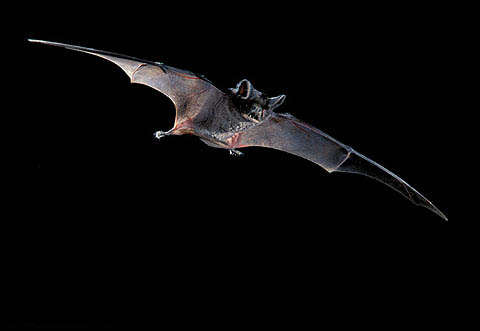 The European Free-tailed Bat (scient. Tadarida teniotis) is a common species of free-tailed bat found mostly in Europe and Western Asia. It is the most common species on Crete, although populations seem to decrease. A bat has a body length of 8.4-9.4 cm, a tail of 4.8-5.6 cm, and a wing length of 5.7-6.5 cm.
The European Free-tailed Bat (scient. Tadarida teniotis) is a common species of free-tailed bat found mostly in Europe and Western Asia. It is the most common species on Crete, although populations seem to decrease. A bat has a body length of 8.4-9.4 cm, a tail of 4.8-5.6 cm, and a wing length of 5.7-6.5 cm.
Summer and winter colonies typically number 5-100 individuals, which forage at 10 to 50 m above the ground over temperate to semi-desert habitats. Apart from small caves, it can be found in fissures and hollows in rock outcrops, quarries, bridges and cliffs.
Greater Horseshoe Bat (Rhinolophus ferrumequinum)
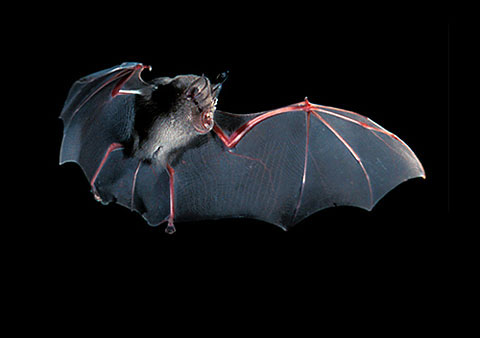 The Greater Horseshoe Bat (scient. Rhinolophus ferrumequinum) is a European bat met in Europe, Africa, South Asia and Australia with a distinctive horseshoe noseleaf. It is the largest of the common European Horseshoe Bats and is thus easily distinguished from them. The species is also met quite often in the caves of Crete.
The Greater Horseshoe Bat (scient. Rhinolophus ferrumequinum) is a European bat met in Europe, Africa, South Asia and Australia with a distinctive horseshoe noseleaf. It is the largest of the common European Horseshoe Bats and is thus easily distinguished from them. The species is also met quite often in the caves of Crete.
This bat is sedentary, travelling between 20 and 30 km between the winter and summer roosts, with the longest recorded movement being 180 km. It feeds on beetles, moths and other insects in Cretan pastures and in trees. Lastly, the species is notable as having the oldest recorded age for any European bat, with a bat living for over 30 years.
Lesser horseshoe bat (Rhinolophus hipposideros)
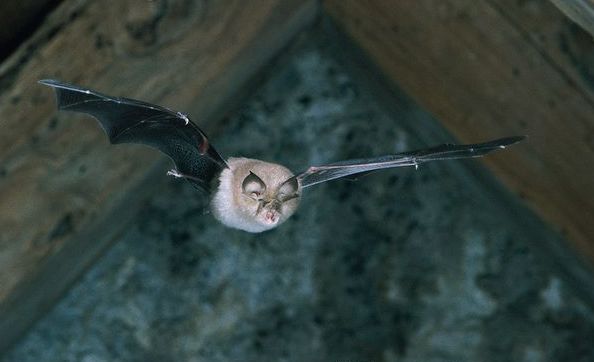 The Lesser Horseshoe Bat (scient. Rhinolophus hipposideros) is one of the world's smallest bats, weighing only 5 to 9 grams, with a wingspan of 192-254 mm and a body length of 35-45 mm. The species gets its name from its distinctive horseshoe-shaped nose. The species has been detected in the Cretan grounds, usually living in some of the thousands caves on the island that are close to small holly forests and shrublands.
The Lesser Horseshoe Bat (scient. Rhinolophus hipposideros) is one of the world's smallest bats, weighing only 5 to 9 grams, with a wingspan of 192-254 mm and a body length of 35-45 mm. The species gets its name from its distinctive horseshoe-shaped nose. The species has been detected in the Cretan grounds, usually living in some of the thousands caves on the island that are close to small holly forests and shrublands.
It has strong feet that it uses to grasp rocks and branches, and can see well in spite of its small eyes. Like most bats, Lesser Horseshoe Bats live in colonies and hunt their prey by echolocation, emitting ultrasound from specialized round pads in their mouth. The bats are sedentary, with the average movement between summer and winter roosts between 5 and 10 kilometers, although the longest recorded distance is 153 kilometers.
Blasius's Horseshoe Bat
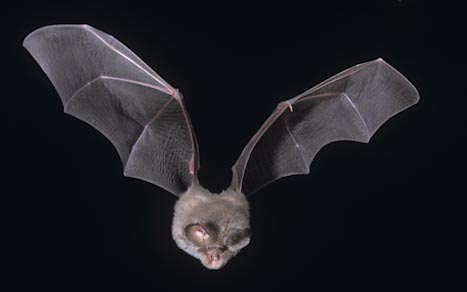 Blasius's Horseshoe Bat (scient. Rhinolophus blasii) is an endangered species of bat which lives in several (inter-isolated) parts of Europe, Asia and Africa. One of these areas is Crete, where an important population of the species lives.
Blasius's Horseshoe Bat (scient. Rhinolophus blasii) is an endangered species of bat which lives in several (inter-isolated) parts of Europe, Asia and Africa. One of these areas is Crete, where an important population of the species lives.
The horseshoe bat of Blasius lives in warm areas with low vegetation and little moisture. Thus, you’ll rarely meet it on the mountains of Crete. One can meet them in caves, mines, old houses and cellars. Usually 3-4 bats live together and hibernate in winter, after finding a warm place.
Blasius bats are medium sized with large wings. Their fur is long and light brown. They have distinctive horseshoe-shaped noseleaves. Lastly, the bat of Blasius has great skill in flyingand can even hunt insects while flying near the ground.
Steppe Whiskered Bat (Myotis aurascens)
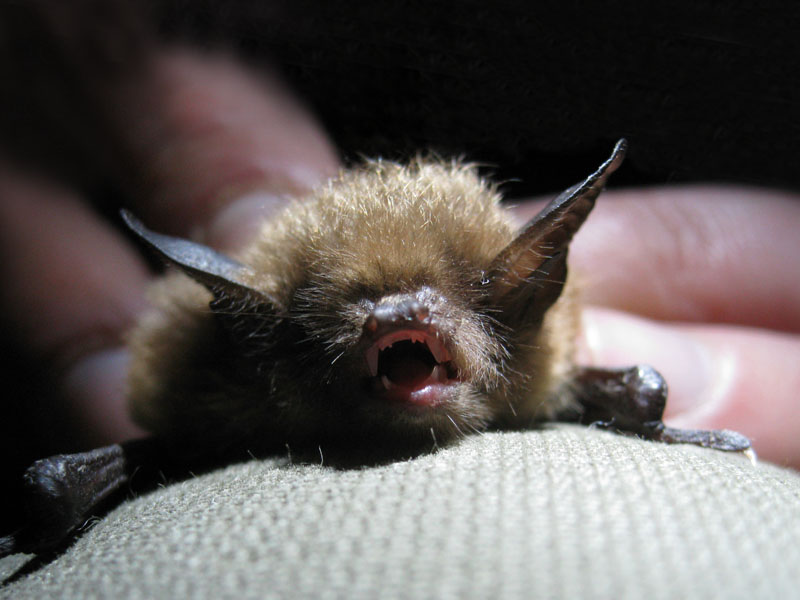 The Steppe Whiskered Bat (scient. Myotis aurascens) is a bat species distributed in south-east Mediterranean and extending eastwards out of the region into steppe Europe and in south-west Asia. It’s also met in the island of Crete, in quite large numbers.
The Steppe Whiskered Bat (scient. Myotis aurascens) is a bat species distributed in south-east Mediterranean and extending eastwards out of the region into steppe Europe and in south-west Asia. It’s also met in the island of Crete, in quite large numbers.
In Crete, it roosts in small caves, rock crevices, cracks and abandoned buildings that are usually near small forests and scrublands. From there it can hunt midges, moths and craneflies. The colonies usually have up to 15 bats, a small number compared to other bat species.
Serotine (Eptesicus serotinus)
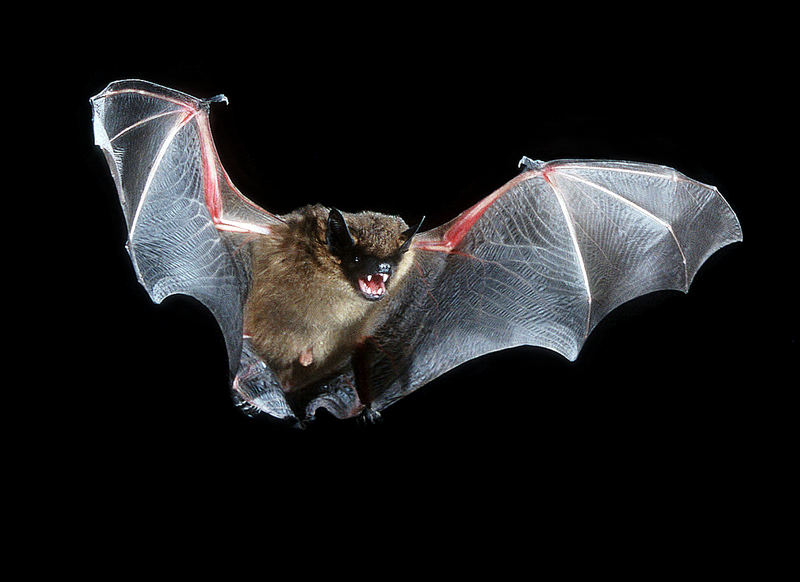 Serotine bat (scient. eptesicus serotinus) is a fairly large bat with quite large ears, widely distributed from the Atlantic to the Pacific seaboards, with Crete being in the middle of this range. In Crete it emerges at early dusk, often when it still fairly light, and hunts mainly for beetles, flies and moths.
Serotine bat (scient. eptesicus serotinus) is a fairly large bat with quite large ears, widely distributed from the Atlantic to the Pacific seaboards, with Crete being in the middle of this range. In Crete it emerges at early dusk, often when it still fairly light, and hunts mainly for beetles, flies and moths.
Serotine bats live up to 19 years of age. Its habitat is includes mainly the woodlands, scrublands and suburban areas of Crete. It can be found mainly in tree holes, rock fissures and in the cellars of deserted farmhouses, where it lives individually or with a 5-10 more bats.
Common Bent-wing Bat (Miniopterus schreibersii)
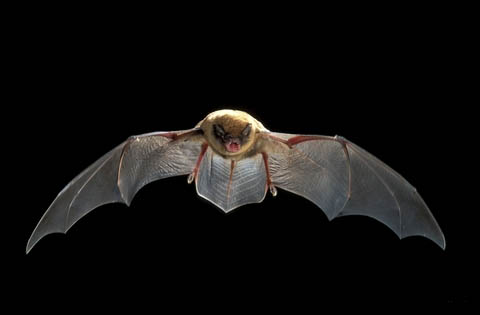 The common Bent-wing Bat (scient. Miniopterus schreibersii), Schreiber's Long-Fingered Bat or Schreiber's Bat is an evening bat, widely distributed in Southern Europe, Africa, South East Asia and Australia.
The common Bent-wing Bat (scient. Miniopterus schreibersii), Schreiber's Long-Fingered Bat or Schreiber's Bat is an evening bat, widely distributed in Southern Europe, Africa, South East Asia and Australia.
The bat can be also met in the island of Crete and can be recognized by its 3rd finger, which is 4 times longer than the middle one, giving the impression of a bent wing. Moreover, it has a short muzzle and a domed head with short, rounded, roughly triangular ears. Its habitat does not differ from the previously mentioned species, which includes mainly Cretan woodland. This species usually eats moths, flies and sometimes, grasshoppers.
Whiskered Bat (Myotis mystacinus)
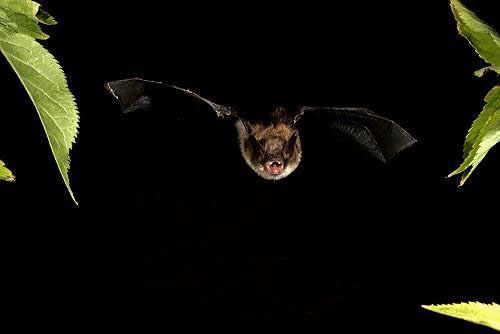 The whiskered bat (scient. Myotis mystacinus) is a widely distributed bat of Europe, which is quite rarely met in Crete. It is a small bat with long fur, found around human habitation and in wooded places close water sources. Indeed, it is generally more a house-dwelling than woodland bat, and is commonly sighted in parks, gardens and villages.
The whiskered bat (scient. Myotis mystacinus) is a widely distributed bat of Europe, which is quite rarely met in Crete. It is a small bat with long fur, found around human habitation and in wooded places close water sources. Indeed, it is generally more a house-dwelling than woodland bat, and is commonly sighted in parks, gardens and villages.
The whiskered bat nests in small colonies, living in trees, amongst rocks, and in livestock pens, and occasionally in caves. It is a nocturnal species emerging to hunt at sunset near waters, but feeds on non-aquatic flying insects, such as mosquitoes.
Geoffroy's Bat (Myotis emarginatus)
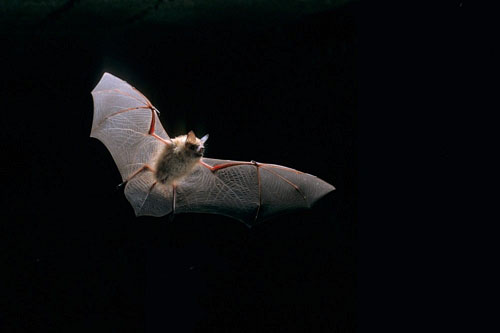 Geoffroy’s Bat (scient. Myotis emarginatus) is a quite rare bat of Crete, distributed in Northwest Africa, Europe and West Asia.
Geoffroy’s Bat (scient. Myotis emarginatus) is a quite rare bat of Crete, distributed in Northwest Africa, Europe and West Asia.
It lives in areas of both high and low altitudes, forming big colonies that can exceed 1000 individuals! More specifically, it occurs from sea level to 1.800 m and lives in small caves and rock cracks.
Especially in Crete, the colonies rarely exceed 200 bats. The species population has faced a decline in the last decades, but it seems that it comes back.
The Long-Fingered Bat (Myotis capaccinii)
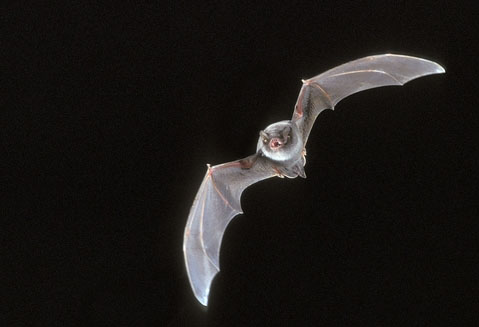 The Long-Fingered Bat (scient. Myotis capaccinii) is a bat species known from Morocco, Algeria, southern Europe and the Middle East as far east as western Iran. In Crete it is not very common, although there are several colonies of up to 100 individuals.
The Long-Fingered Bat (scient. Myotis capaccinii) is a bat species known from Morocco, Algeria, southern Europe and the Middle East as far east as western Iran. In Crete it is not very common, although there are several colonies of up to 100 individuals.
It can be recognized by its large feet and the prominent nostrils. In Crete it nests mostly in caves near limestone areas, with preferably wooded or shrubby terrain, always near flowing water. It only hunts in watercourses and is therefore threatened by water pollution and the development of tourist infrastructure, which is expected to continue in the future.
The Lesser Mouse-Eared Bat (Myotis blythii)
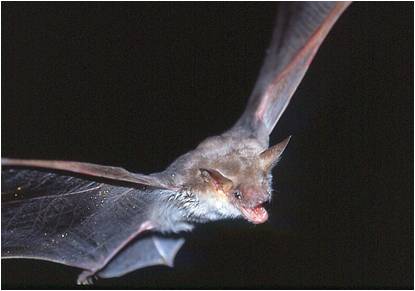 The Lesser Mouse-Eared Bat (scient. Myotis blythii) is a large-sized bat, around 62 to 70mm long, distributed from South Europe to China, with a small population being spread in Crete.
The Lesser Mouse-Eared Bat (scient. Myotis blythii) is a large-sized bat, around 62 to 70mm long, distributed from South Europe to China, with a small population being spread in Crete.
The population of Crete is not very big and seems to have slightly declined in the recent decades.
These bats like mainly grassland and scrub and nest mainly in caves and less in old houses. As most bats of Crete, it hibernates in winter in underground sites with a relatively constant temperature of 6-12°C.
Mountain Long-eared Bat (Plecotus macrobullaris)
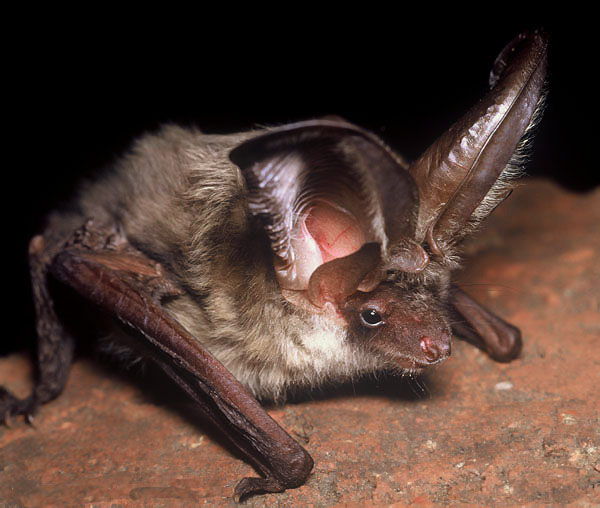 The Mountain Long-eared Bat (scient. Plecotus macrobullaris) is a rare species of bat distributed mainly in Alps, Balkans and the region of Turkey. In Greece it can be found in the west shores of the country and in Crete.
The Mountain Long-eared Bat (scient. Plecotus macrobullaris) is a rare species of bat distributed mainly in Alps, Balkans and the region of Turkey. In Greece it can be found in the west shores of the country and in Crete.
Since 2003 it was considered to belong to a different species, thus it has not been studied adequately. The bat can live in altitudes till 2800m, hence its name.
In Crete, the bat is found in caves located in the mountain ranges, surrounded by oak and pine forests. Apart from caves, it likes also nesting inside abandoned dark farmhouses.
Kuhl's Pipistrelle (Pipistrellus kuhlii)
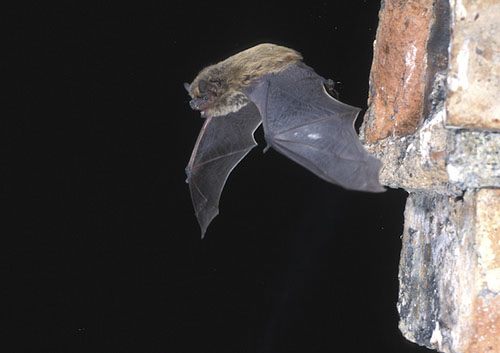 Kuhl's Pipistrelle (scient. Pipistrellus kuhlii) is one of the mostly met bat species in Crete. The species is distributed all around the Mediterranean sea, Europe and Arabia, with Crete being located in the center of this distribution. The bat is characterized by a thin white line, running along the lower edge of its wings. Indeed, due to this white line, Greeks call this species white bat, although it is brownish.
Kuhl's Pipistrelle (scient. Pipistrellus kuhlii) is one of the mostly met bat species in Crete. The species is distributed all around the Mediterranean sea, Europe and Arabia, with Crete being located in the center of this distribution. The bat is characterized by a thin white line, running along the lower edge of its wings. Indeed, due to this white line, Greeks call this species white bat, although it is brownish.
It is a very common species, mainly because it can be met in altitudes ranging from the sea level, to the alpine zones of White Mountains and Ida Mount. The colonies typically number 30-100 bats that feed mostly on insects, flies and mosquitos. They eat 50% of their weight per day and can catch more than 3000 flies in one night. They fly over different habitats, ranging from dry shrubland and urban places, to lakes and forests.
Savi's Pipistrelle (Pipistrellus savii)
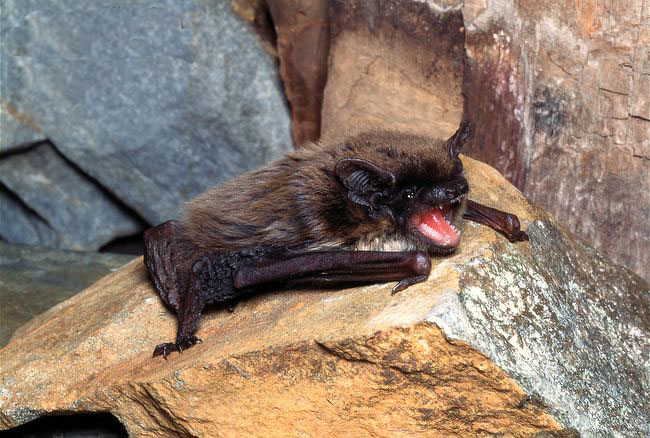 Savi’s pipistrelle (scient. Pipistrellus savii), also known as Hypsugo savii, is a very common bat in Crete, met in most areas of the island. This species has a wide range from southern Europe and North Africa, to Middle East and India.
Savi’s pipistrelle (scient. Pipistrellus savii), also known as Hypsugo savii, is a very common bat in Crete, met in most areas of the island. This species has a wide range from southern Europe and North Africa, to Middle East and India.
It is usually met in wall crevices and holes, old houses, tree holes, under cavernous rocks, etc. The Savi’s pipistrelle has a share of similarities with the previous mentioned species of Kuhl’s pipistrelle. They live rather close to each other, and their eating habits, selection of homes, hunting behavior, and reproduction are found to be very similar.
The Common Pipistrelle (Pipistrellus pipistrellus)
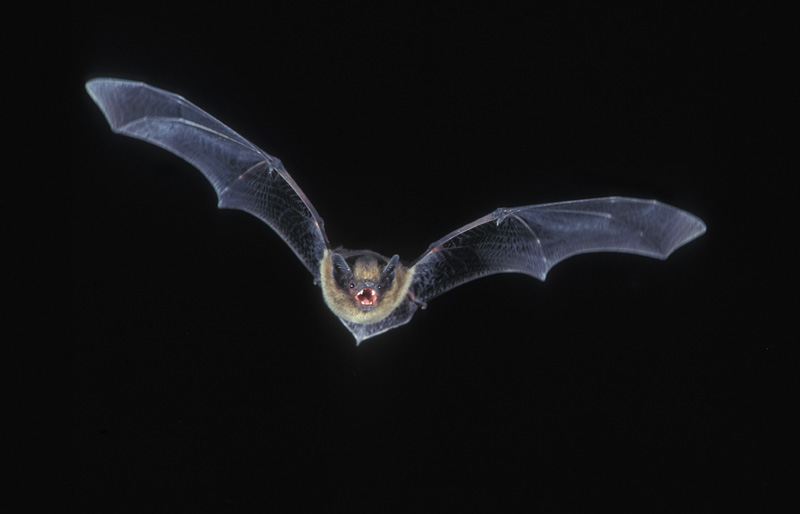 The Common Pipistrelle (scient. Pipistrellus pipistrellus) or common dwarf bat is a tiny species of bat, which’s very large range extends across most of Europe, North Africa and southwestern Asia. It is one of the bat species found in Crete, which’s population is however threatened with decline.
The Common Pipistrelle (scient. Pipistrellus pipistrellus) or common dwarf bat is a tiny species of bat, which’s very large range extends across most of Europe, North Africa and southwestern Asia. It is one of the bat species found in Crete, which’s population is however threatened with decline.
It is common in woodland and farmland but is also found in towns, where it roosts in lofts and buildings. It weighs only 3g, but can live for 16 years. Till 2004, another species of Crete was falsely considered to belong to the common pipistrelle. This is the Hanaki’s pipistrelle, which is native to Crete and Libya.
Hanaki's Dwarf Bat (Pipistrellus hanaki)
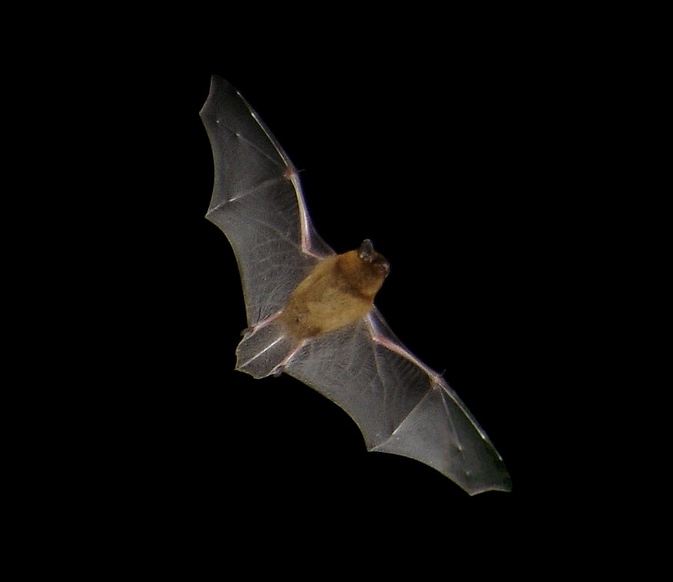 Hanaki's Dwarf Bat (scient. Pipistrellus hanaki) was found to be a separate species only in 2004, and until then it was considered as belonging to the more common species of Pipistrellus pipistrellus. The species has been found so far only in Libya and Crete, but it’s possible to exist elsewhere. The Hanaki bat populations of Crete differ morphologically and genetically from the common Pipistrellus hanaki in Libya, constituting a separate endemic taxus.
Hanaki's Dwarf Bat (scient. Pipistrellus hanaki) was found to be a separate species only in 2004, and until then it was considered as belonging to the more common species of Pipistrellus pipistrellus. The species has been found so far only in Libya and Crete, but it’s possible to exist elsewhere. The Hanaki bat populations of Crete differ morphologically and genetically from the common Pipistrellus hanaki in Libya, constituting a separate endemic taxus.
It has been reported in over 30 locations in Crete, ranging from the mountains of Dikte to the west part of the island, in Chania Prefecture. On autumn the species congregates with other bat species in caves in high altitude regions, where it possibly winters. It is likely that the area of spread is wider and the probability of exceeding the limits of Crete cannot be excluded. In Crete the Hanaki’s bat depends on mature forests, clusters of hollies and chestnuts and wetlands. Its preference on these threatened habitats of the island and the fragmented distribution make it vulnerable to any environmental threats and dangers.










 Bats
Bats 


































































